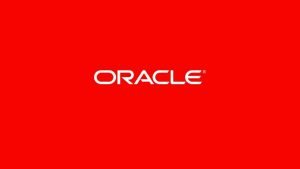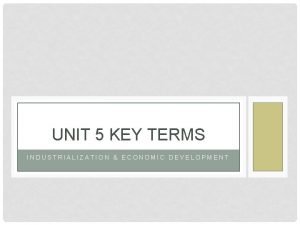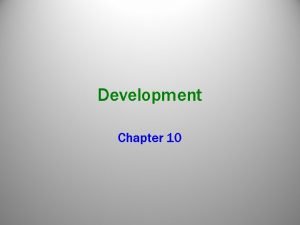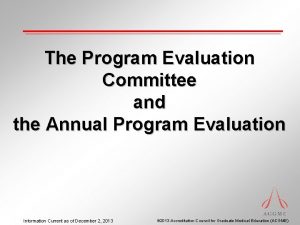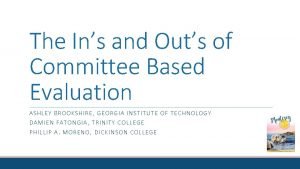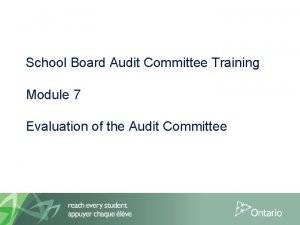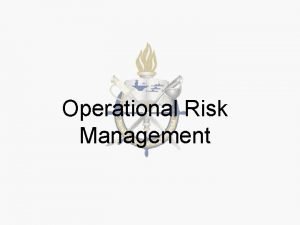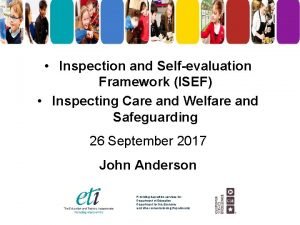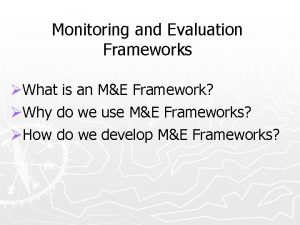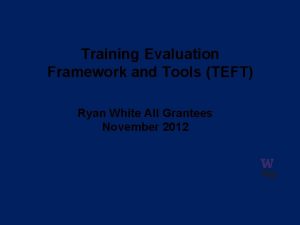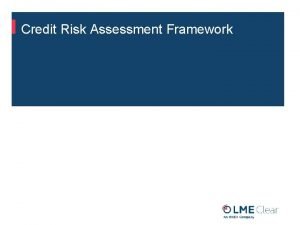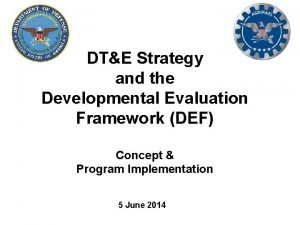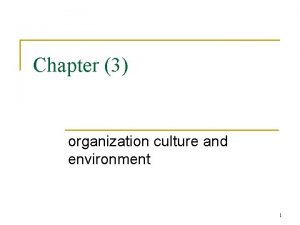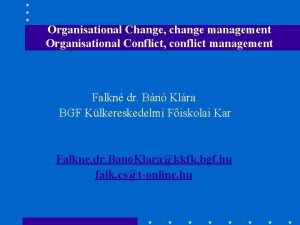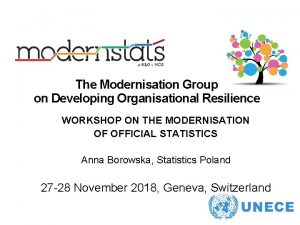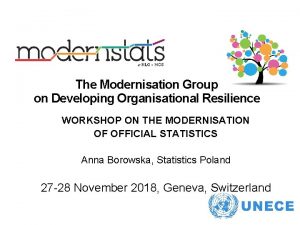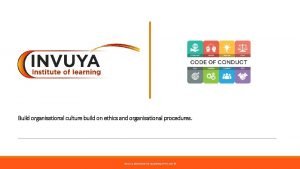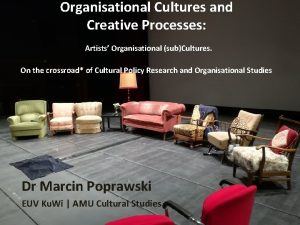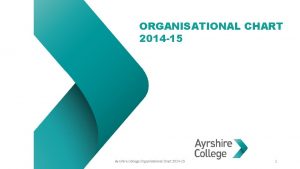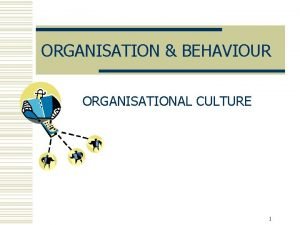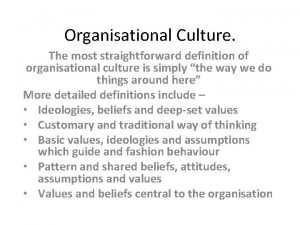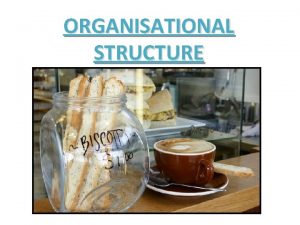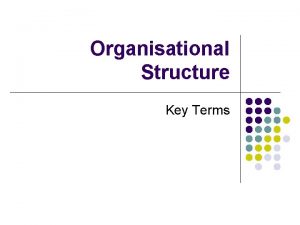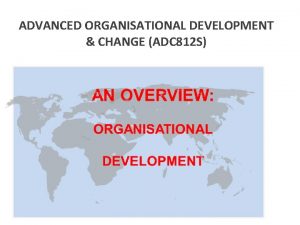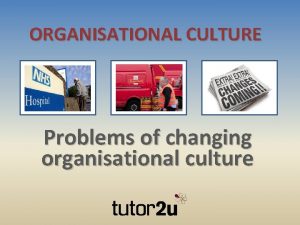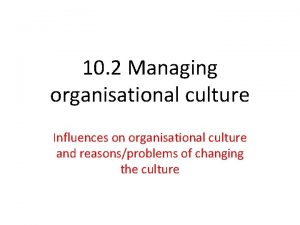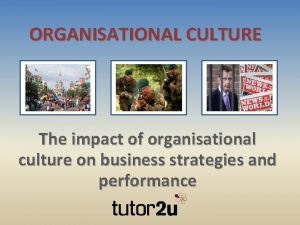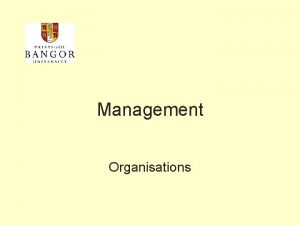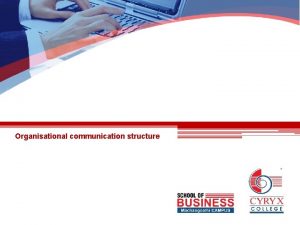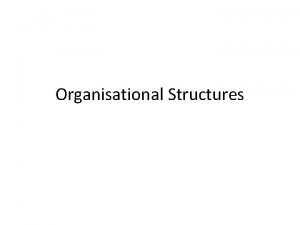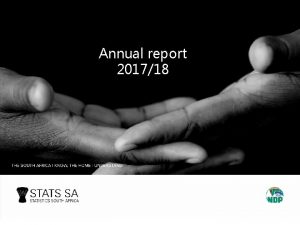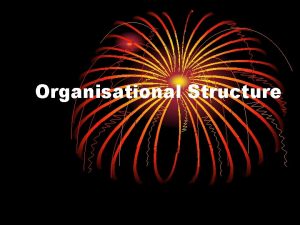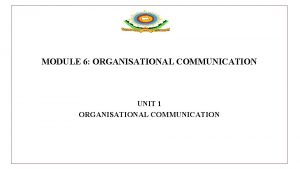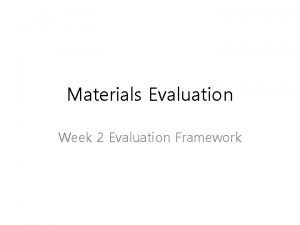Modernisation Committee on the Organisational Framework and Evaluation






































- Slides: 38

+ Modernisation Committee on the Organisational Framework and Evaluation: Report on progress in 2016 Jackey Mayda, Fabrizio Rotundi, Michael Quinlan On behalf of the Modernization Committee

+ 2 Committee Members n Jackey Mayda (Canada – Chair) n Marie Creedon, Eilish O’Sullivan (Ireland) n Milena Grassia, Antonio Ottaiano, Fabrizio Rotundi (Istat) and Prof. Alessandro Hinna (University of Rome, Tor Vergata) n Carina Fransen, Wouter Jan van Muiswinkel (Netherlands) n Ingvild M. Moller, Anne Trolie (Norway) n Anna Borowska (Poland) n Thana Chrissanthaki (Eurostat) n Jonathan Challener (OECD) n Tetyana Kolomiyets, Steven Vale (UNECE Secretariat)

+ 3 Priority areas n Risk management guidelines n Human Resources Management and Training n Workshop n Guidelines for managers n Organizational barriers to international collaboration n Developing a Modernization Maturity Model (MMM) for the implementation of the HLG-MOS standards (GSBPM, GAMSO, GSIM and CSPA) n Evaluation of the project cost benefit analysis methodology developed by Eurostat

+ 4 Risk management n Draft guidelines on risk management practices in statistical organizations drafted based upon 2 surveys n A third questionnaire sent out to specific countries in order to get more detail on lessons learned (what was most successful, what was most difficult, what not to do when implementing risk management) n Organized Risk Management workshop in Geneva, April 2016 n n Positive feedback received, particularly from countries that are at a lower level of maturity of risk management implementation n A task team on risk management in the context of agile development created as a result of the workshop and will continue into 2017 Final version of the guidelines presented for your approval

WORKSHOP ON THE MODERNISATION OF OFFICIAL STATISTICS Guidelines on Risk Management practices in Statistical organisations Modernisation Committee on the Organisational Framework and Evaluation - MCOFE Genève, 22 November 2016 Fabrizio Rotundi Page 5

• Defining the research framework • Designing the project • Choosing the criteria for analyzing practices: ‒ Rationalities ‒ Uncertainty Experts ‒ Technologies 1. Specify needs 2. Design 2014 The overall project • Providing the 3 surveys: 1^ RM practices: 64 NSOs and 34 respondents; 2^ RM In-depth: 14 NSOs and 11 respondents; 3^ RM What(s): 27 NSOs and 15 respondents 3. Build 4. Collect data • Integrating data from the surveys • Combining practices for the best practice • Integrating Guidelines with case studies and comments 5. Process Fabrizio Rotundi • Setting up 3 surveys: 1. General 2. In-depth 3. Lessons learned • Developing supporting tools • Connecting variables and dimensions 6. Analyze 2016 2015 • Sharing RM practices • Identifying good/best practices • Defining RM practices most fitting to statistical organizations • Drafting RM Guidelines • Analyzing RM maturity • Integrating RM with Quality management • Sharing common risks among NSOs focusing on statistical risks a. 1 st general survey b. Selecting practices by: • Re-applicability • Coherency • Compliance d. 2 nd in-depth survey e. First draft (Workshop RM) f. Collecting comments g. 3 rd survey: Difficult, Successful, NOT to do h. Finalizing draft Page 6 7. Dissemi nate 8. Evaluate 2017 • Workshop on Risk Management (4/16) • Sharing and publishing the Guidelines • Communicating RM results • New workshop on RM in 2017?

1 st First Survey on Risk Management practices PROCESS MAPPING Respondent 5 (EU): “Yes. The process mapping concerns the whole organization” Respondent 6 (Non-EU) “Yes. There is a graphic presentation of a process showing the sequences of RM” Fabrizio Rotundi Respondent 4 (EU): “Yes. Previous activities were the basis for identifying, understanding and solving risks”. Page 7

Survey analysis: Defining Parameters and Descriptors Ø Items represent consistent sets of significant features for analysis complying with the 3 Readingkeys (Risk rationalities, Uncertainty experts, Technologies) identified in the Survey design phase. Ø Parameters and Descriptors allocates all countries among the levels Low-Medium-High. Fabrizio Rotundi Page 8

2 nd Survey on Risk Management features Ø 7 Countries have been selected to provide in-depth information about the RM practices that have turned out to be most fitting to some strategic features. Ø 7 Countries have been selected to be submitted with tailored short questionnaires on specific items apparently well developed within those countries. Ø 11 Respondent countries: respectively 6 for in-depth, and 5 for short. Respondent 4 (EU): “For all areas (statistical, support, ICT), a list of activities was defined, linking objectives, processes, business units, accountabilities, deadlines and outputs. ” PROCESS MAPPING Respondent 5 (EU): “The process map describes staff, activities, responsibilities, sequence and links between the sub-processes and documentation”. Fabrizio Rotundi Respondent 6 (Non-EU): “Process Mapping involved core processes, operational activities in detail, using the IDEF 0 Model since 4 years”. Page 9

Guidelines’ structure and contents The Guidelines consists of: A. two sections whose scheme complies with the Risk Management standard ISO: 31000/2009: v Risk Management system; v Risk management process B. The Annex providing a more practical approach showing: – Focus points on Risk Management core topics, to share practices able to substantiate "theoretical" contents; – Case-studies, reporting the most significant experiences to share the know-how gained from implementing Risk Management and highlight common elements C. The References reporting the main sources of the Guidelines D. The Glossary including definition of the main relevant terms of the Guidelines, arising from practices and international standards. Fabrizio Rotundi Page 10

Section 1 - The Framework: Policy, Accountability and Integration ISO 31000: 09 ‒ The risk management policy should clearly state the organization's objectives for, and commitment to, risk management. ‒ The organization should ensure that there is accountability, authority and appropriate competence for managing risk. PRACTICES (from surveys) ‒ “The risk appetite will only tolerate High or Extreme risks when treatment measures are unable to reduce the level of inherent risk to an acceptable level”. “Better quality management practices has been endeavored through the risk mitigation strategy. ” ‒ “The governance is provided by the Executive Management. Directors, Assistant Directors, Chiefs and Unit Heads are owners of Operational risk and Project risk registers. All Staff are responsible for identifying, documenting and managing operational and project risks. “ GUIDELINES ‒ Risk philosophy (strategy) and risk appetite (policy) should be always kept aligned. ‒ Risk management responsibilities belong to: A. The Chief Statistician for ensuring an effective RM B. The Risk Committee for validating: …. . C. The Risk Manager for acting: … ‒ Statistical risks (i. e. the possibility that one or more of the production process components fail to meet the quality standard) are managed at all levels (strategic, operational and project ones). Even when managed separately risks should be integrated into the same risk framework. Fabrizio Rotundi Page 11

Section 2 - The Process: Risk Identification and Assessment ISO 31000: 09 ‒ The organization should define criteria to evaluate the significance of risk ‒ The organization should identify sources of risks, areas of impacts, events (including changes in circumstances), causes and potential impacts. ‒ Risk evaluation assists in making decisions, based on the outcomes of risk analysis, about risk treatment and prioritization PRACTICES (from surveys) ‒ “Risks are identified by accountable managers and then gathered in strategic categories (corporate risks), in order to be assessed, treated and monitored, based on: Monitoring risk treatments; Organizational sustainability; Cross-cutting activities; priority areas”. ‒ “ 3 levels of risks have been identified: 1. Risks associated to the ESS Vision 2020; 2. Portfolio management risks; 3. Project related risks”. ‒ “The RM matrix is a tool for identifying, analyzing, evaluating and treating risks”. GUIDELINES ‒ The coordination of Risk Management process phases is centralized ‒ Three kinds of approach can be followed in identifying risks: Top-Down; Bottom-Up; Mixed. ‒ The RM framework includes a hierarchy of risks: A) Enterprise; B) Operational; C) Project. ‒ The risk weighting ensures that use of resources will be focused on the most important risks. A common approach to prioritize risks is to divide them into 3 bands: Upper; Middle; Lower. Fabrizio Rotundi Page 12

3 rd Survey - Lessons learned when implementing RM Objective: highlighting the following aspects occurred in implementing Risk Management: “WHAT WAS MOST SUCCESSFUL”; “WHAT WAS MOST DIFFICULT”; “WHAT NOT TO DO” The Survey is made up of 6 questionnaires addressed to as many organizational areas: 1. Risk Management; 2. Statistical quality analysis; 3. Statistical production process management; 4. Organizational process management; 5. Internal control and/or internal auditing; 6. Services supporting statistical production. Involved Institutes and Organizations Respondents Overall Redemption Double responses Total of questionnaires Questionnaires completed Overall questionnaires redemption Double responses 27 16 59, 3% 3 162 65 40, 1% 3 As far as the contents are concerned, each questionnaire focuses on 4 main subject areas: 1) RISK MANAGEMENT FRAMEWORK 2) RISK MANAGEMENT PROCESS 3) OVERARCHING PROCESSES 4) ORGANIZATION RISK MATURITY Fabrizio Rotundi Page 13

3 rd Survey: Consistency analysis Ø The topics were selected analyzed with regard to their consistency both inherent and with the guidelines, through the evidences coming from RM, Quality management and Auditing Ø practices. The results from the Survey have been grouped in 5 clusters: 1) Mandate and policy; 2) procedure and role of RM office; 3) Integration with other functions; 4) RM process; 5) supporting process CLUSTER 3 - RISK MANAGEMENT PROCESS Item Risk Identifi cation phase Plus&Minus Organizational Area Statistical Production Area Statistical Quality Area Successful Ensuring risks align with other corporate strategies Framing quality risks in an holistic manner to ensure the risks best reflected the totality of key stakeholder’s expectations around quality Performing regular quality review of statistical surveys Difficult Not to do Fabrizio Rotundi Determining risk Establishing relation/link between strategic owners when risks and operational risks occur in different areas Identifying too many risks and risks which aren't risks Identifying emerging risks or planning for unanticipated risks Identifying risks Focus only on one dimension of risk (for without necessary example, cyclical risk) or on only a narrow view stakeholders in the of quality. Page 14 discussion

The continuous cycle of Risk Management improvement Analysing the NSO’s practices a common path to improve the RM System was observed 1) IDENTIFYING DIFFICULTIES AND GAPS v Lack of integration of RM into business processes v Lack of responsibilities for managing key statistical risks v Ineffectiveness of internal controls ü Human Resources inadequacy: expertise in a few people ü Lack in communicating and sharing risks policy Ø Misunderstanding risk appetite Ø Mismatching stakeholders’ expectations 4) IMPROVING RM PRACTICES v Developing Statistical RM Plans to improve RM approach at the operational level ü Changing RM culture by focusing on training, communicating and consulting; understanding and managing risks in common Ø Implementing RM tools aiming at standardizing RM procedures and controls Ø Reviewing framework by consulting stakeholders Fabrizio Rotundi 2) ESCALATING RM MATURITY LEVEL v Regularly reviewing RM Framework leading to RM in practice ü Increasing Staff Risk Awareness and periodically evaluating human resources adequacy Ø Clearly detailing Risk appetite at operational level; ensuring coherent approach with statistical quality Ø Periodically evaluating stakeholders’ needs 3) ENHANCING CAPABILITIES v Integrating controls and Auditing by business units, managers and employees ü Communicating the Risk policy within the organization to strengthen staff sense of belonging Ø Managing quality of services and activities Ø Communicating the organization and strengthen citizens’ and users’ trust Page 15

Proposals for next Risk Management activities 1. MCOFE RM ACTIVITIES IN 2017 2. GUIDELINES FOLLOW-UP Ø Developing Agile approach within the task team v Communicating Guidelines Ø Integrating Risk and Quality Management: v Sharing common risks among NSOs ”Business Case for organizing a Work Session on Implementing Efficiencies & Quality of output” v Focusing on Statistical and Quality Risks 3. ASSESSING RISK MANAGEMENT MATURITY 1. RM Committment and Strategy 2. RM Dissemination: Benefits, Outcomes, Impacts 3. RM Integration 4. Roles & Responsibilities 5. Stakeholders Relationship 6. Risk Analysis 7. Risk Treatment & Resources Adequacy 8. RM Information System Fabrizio Rotundi Page 16

Risk Management Maturity Model (Example from Guidelines) To deeper understand RM, a multidimensional analysis is proposed based on different sources: actual cases of RM systems implementation among statistical organizations; selected case-studies, significant experiences of NSOs; maturity models from techniques and literature. MULTIDIMENSIONAL ANALYSIS AND READING GRID: Risk Management MATURITY READING KEYS RISK RATIONALITIES: RM FRAMEWORK AND PROCESSES UNCERTAINTY EXPERTS: PEOPLE, ROLES, STRUCTURES AND INTERACTIONS TECHNOLOGIES: SUPPORTING SYSTEMS ITEMS / CORE AREAS Risk Framework DESCRIPTORS Fabrizio Rotundi STAGE (LEVEL) 2 STAGE (LEVEL) 3 STAGE (LEVEL) 4 Attributes / Performance indicators No proactive thought: Attitude the organization is towards reacting to situations uncertainties and risk issues after they (Risk occur and it is not able to Philosophy) distinguish between positive and negative risk RM function Organizational in the chart organization RM Information system STAGE (LEVEL) 1 Opportunistic approach: a common and consistent Risk is considered a static definition of risk exists and is phenomenon instead of a applied throughout the dynamic one. Risk approach organization, but risk mainly focuses on past events approach mainly focuses on avoiding unexpected large loss events Top management / senior The board does not feel managers take the lead to the need to manage risk ensure that a not-formalized and the related function core group of people have the is not included in the basic knowledge to manage organization chart risk. An experimental / pilot function is being introduced Record management supporting activities and decisions is focused on Document physical and financial management assets. The organization does not document information about risk A document management system, mainly focused on past events, may be envisaged: 1. to comply with legal and governance requirements; 2. to record information Page 17 referring to stand-alone processes and treatments. Open and proactive approach to risk that considers both threat and opportunity. Risk based approach to achieve goals is used at all levels An independent operational risk management function RM function is formalized exists. Staff responsible for within the organization and implementing the entity’s risk a specific RM unit may be management framework are envisaged in the dedicated to RM, with a well organization chart developed understanding of the entity and its operations Organization identify resources in terms of document systems to support management in recording key and relevant process areas Information about risks are recorded in a consistent and secure way, establishing the policies and procedures needed to access, use and transfer information, as part of a structured Information Management Plan.

Fabrizio ROTUNDI rotundi@istat. it fabrizio. rotundi@gmail. com Experience makes the difference … Fabrizio Rotundi Page 18

Enhancing Risk Management with Agile Principles Presented by Michael Quinlan, CSO Ireland, on behalf of the Task Team working to the UNECE Modernisation Committee on Organisational Framework and Evaluation (MCOFE) under the wider High-Level Group for the Modernisation of Official Statistics (HLG-MOS) www. cso. ie 19

Introduction/ context • Ongoing work at UNECE to strengthen R. M. in Stat organisations – e. g. new draft guidelines – significant initiative ! • Increasing use of project management leading to increased use of Agile practices • During last workshop in April to discuss R. M. guidelines some tensions were highlighted between twin development of R. M. and Agile www. cso. ie 20

Defining Agile • • • An iterative approach to project management Roots in IT project management Promotes rapid and flexible response to change Common techniques (Scrum, Kanban, …) Focuses on the delivery of fit-for-purpose solutions early and often www. cso. ie 21

Tensions highlighted • Agile practitioners see explicit R. M. as unnecessary/ out of date • R. M. practitioners think Agile is weak on assurance • Short-term v. long-term planning - Agile adopts a more short-term (sprint) focus – needs to be fitted into longer-term strategic working of the organisation www. cso. ie 22

Task team set up To look at ways to minimise tensions and maximise synergies, i. e. 1. Ways to alleviate any potential tensions between R. M. and Agile project delivery 2. Ways to capitalise on opportunities inherent to Agile to support Stat. Organisations enhance their implementation of R. M. www. cso. ie 23

Exploiting Agile to strengthen R. M. – 3 principles • Principle 1: Define your appetite for risk, and make it real • Principle 2: Identify threats and opportunities – shift focus from mitigating threats to exploiting opportunities • Principle 3: Deal with threats and exploit opportunities at the most appropriate level but document and escalate if necessary www. cso. ie 24

Conclusion • “What we have shown is a reconciliation between R. M. and Agile to make sure R. M. is fundamentally about effective decision making, to take advantage of Agile delivery as a process which inherently reduces risk, and to exploit Agile practices for better R. M. ”. www. cso. ie 25

Next Steps • Focus on practical application • Further consideration of case studies and maturity model • Supporting each other with implementation of the principles • Follow-up workshop of wider community to consider such things as register of the highest common risks to statistical organisations www. cso. ie 26

Members of Task Force • • • Ben Whitestone and Rich Williams, ONS UK (Co-Chairs) Michael Quinlan, CSO Ireland Michael Goit and Sarah Mac. Kinnon, Statistics Canada Phillip Wise, Carrollyn Wall and Patrick West ABS Fabrizio Rotundi and Marco Tozzi, Istat Alessandro Hinna and Federico Ceschel, University of Rome Armando Zuñiga, INEGI Mexico Anna Borowska and Agnieszka Komar-Morawska, CSO of Poland Olja Music, Statistical Office of the Republic of Serbia Alexander Sindram, Statistics Netherlands Alessandra Politi, Eurostat Steven Vale and Tetyana Kolomiyets, UNECE www. cso. ie 27

Thank You • Any questions / observations etc. www. cso. ie 28

+ 29 Human Resources and Training workshop n Held in Krakow, Poland September 7 -9 n 67 participants, representing 40 countries or intergovernmental organizations n Theme: Developing capabilities for the future n Sessions included n n n Special session for the Eastern Europe, Caucasus and Central Asia (EECCA) countries n n practical training and learning materials staff motivation and employee engagement managing human resources in the context of modernization best practices in capabilities development focused on what could be implemented in these countries based upon discussions held at the HRMT workshop Very positive feedback overall

+ Guidelines for managers including best practices n English guidelines were published on the wiki last year n In preparation for the Human Resources and Training Workshop and special session for EECCAA countries, the Russian version of the guidelines was made available http: //www 1. unece. org/stat/platform/pages/viewpage. action? page. Id=123145021 30

+ Organizational barriers to international collaboration n Explore how international collaboration can be fully realised n Sub-group members from OECD, Eurostat, the Netherlands, Istat and Canada n Initially 12 barriers identified, then prioritised and narrowed down to 4 to be described in detail 31

+ 32 Initial list of barriers Legal External communication Burden on lead organisations Lack of coordination inside statistical offices Human and financial resources Stakeholder engagement Internal communication Lack of coordination between organisations Internal vs. external barriers Selection of people involved Work being done ‘on the corner of the desk’ Mandate/vision

+ 33 Barriers of focus Legal External communication Burden on lead organisations Lack of coordination inside statistical offices Human and financial resources Stakeholder engagement Internal communication Lack of coordination between organisations Internal vs. external barriers Selection of people involved Work being done ‘on the corner of the desk’ Mandate/vision

+ Organizational barriers to international collaboration (cont’d) n Documented the barriers, identified existing practices, and made recommendations on possible solutions and best practices n Sought input of the HRMT workshop participants as well as other MCs n Many comments received, lots of interest in this topic n Organisational barriers to international collaboration_26102016. docx n Next step: dissemination on UNECE wiki 34

+ 35 Evaluation - project cost benefit analysis methodology n Methodology aimed at assessing the impact of the projects that will enable the implementation of the ESS Vision 2020 n Based on the work of the ESSnet on Standardisation and of the Eurostat Task Force Impact assessment of ESS. VIPs n Relies on two types of assessments: n n Qualitative assessment based on a SWOT analysis (Strengths, Weaknesses, Opportunities and Threats) n Quantitative assessment based on an estimation of current costs, development costs and future costs of production Group recommended this methodology as an evaluation tool for the activities under the HLG

+ 36 Modernisation Maturity Model (MMM) n Working in conjunction with the MC on Standards as part of the Implementing Modernstats Standards project n MMM outlines the various levels of maturity of implementation of each of the HLG-MOS standards (from initial awareness to mature implementation), as well as the dimensions (business, methods, information, application, technology) n Led the testing of the MMM in July and August n Revised version of the MMM presented to the participants attending the Workshop on Implementing Standards held in Geneva Sept 21 -23 n Revised MMM circulated to participants for review and will be presented later in the workshop

+ 37 Next steps n Work in the area of risk management in the context of agile development will continue n Communication strategy for MMM and implementing standards roadmap n Two activity templates propose new work to be undertaken by the committee in 2017 n n Organizing a Work Session on Implementing Efficiencies & Quality of output Training and Capabilities development based upon GSBPM n Further work on barriers to international collaboration? n Revised MC structure n Will evolve to be part of the Capabilities and Outreach MC, which will combine the existing activities of the MCOFE and the Task Team on Communicating Modernisation.

+ 38 Thank you for your attention!
 Difference between modernisation and globalisation
Difference between modernisation and globalisation Oracle forms modernisation
Oracle forms modernisation Rrrlf in library science
Rrrlf in library science Modernisation theory
Modernisation theory Modernization theory
Modernization theory Program evaluation committee checklist
Program evaluation committee checklist Committee based evaluation
Committee based evaluation Audit committee evaluation
Audit committee evaluation Orm time critical risk management
Orm time critical risk management Inspection and self evaluation framework
Inspection and self evaluation framework Me framework
Me framework Example of theoretical and conceptual framework
Example of theoretical and conceptual framework Decide evaluation framework
Decide evaluation framework Training evaluation framework
Training evaluation framework Credit risk evaluation framework
Credit risk evaluation framework Developmental evaluation framework
Developmental evaluation framework Strong and weak organisational culture
Strong and weak organisational culture Organisational conflict and change
Organisational conflict and change Dispositional framework vs regulatory framework
Dispositional framework vs regulatory framework Theoretical framework maker
Theoretical framework maker Theoretical framework
Theoretical framework Dispositional framework vs regulatory framework
Dispositional framework vs regulatory framework Theoretical framework
Theoretical framework Hát kết hợp bộ gõ cơ thể
Hát kết hợp bộ gõ cơ thể Slidetodoc
Slidetodoc Bổ thể
Bổ thể Tỉ lệ cơ thể trẻ em
Tỉ lệ cơ thể trẻ em Gấu đi như thế nào
Gấu đi như thế nào Tư thế worms-breton
Tư thế worms-breton Chúa yêu trần thế
Chúa yêu trần thế Môn thể thao bắt đầu bằng từ đua
Môn thể thao bắt đầu bằng từ đua Thế nào là hệ số cao nhất
Thế nào là hệ số cao nhất Các châu lục và đại dương trên thế giới
Các châu lục và đại dương trên thế giới Công thức tiính động năng
Công thức tiính động năng Trời xanh đây là của chúng ta thể thơ
Trời xanh đây là của chúng ta thể thơ Cách giải mật thư tọa độ
Cách giải mật thư tọa độ 101012 bằng
101012 bằng độ dài liên kết
độ dài liên kết Các châu lục và đại dương trên thế giới
Các châu lục và đại dương trên thế giới

